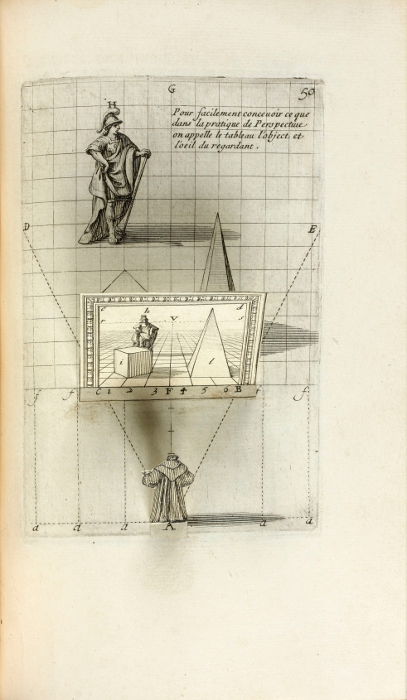Paris, chez l’Auteur, 1665.
8vo [207 x 130 mm] of (3) bl. ll., 1 engraved frontispiece, (16) pp. included 4 pp. of table of contents, 140 pp., 1 engraved title and 67 numbered plates including 1 on double-page and 1 with a movable part. Plates 6 and 7 are repêted twice. Bound in contemporary full red morocco, gilt fillets on the covers with fleurons at corners, spine ribbed and decorated with gilt fleurons, inner gilt border, gilt edges. Contemporary binding.
First edition and first issue of this handbook on perspective written and illustrated by Abraham Bosse. Cicognara, 816; Brunet, I, 1127.
“If trêtises of architecture from the 17th and especially from the 18th century use the line of shadows with an eternal sun at 45 degree, they didn’t comprise any chapter dedicated to the construction methods of this line. In the 17th century, the most complete work on this subject remains the ‘Traité des pratiques géométrales et perspectives’ by Abraham Bosse of 1665.” (J. Sakarovitch, Epures d’architecture, p. 83)
“The first work in which we find some rules for the construction of bas-reliefs is the ‘Traité des pratiques géométrales et perspectives’ by the famous engraver Abraham Bosse, professor of perspective at the Académie royale de Peinture et de Sculpture. The author says that ‘those who are dêling with making bas-reliefs, without knowing the perspective, make big mistakes, not distinguishing the parts the eye must or mustn’t see; that true bas reliefs must only be considered or seen from one place, as a painting, and must have little relief. […] The construction rule given by Bosse, after those observations, doesn’t differ from the one which naturally derives from the uses of the ‘échelle fuyante’ in ordinary perspective. Consequently, the author gives the title: ‘Make the perspective scales for the bas reliefs’. Bosse had mathematical knowledge that allowed him to dêl intelligently with all the questions of perspective and cutting of stones; however he insisted on being only the sprêder of the conceptions of Desargues, and on têching in his own works, as well as in his Lessons of the Academie de Peinture et de Sculpture, only the methods of this erudite geometer, dignified contemporary and friend of Descartes, of Fermat and of Pascal. So we can think that the principles of construction of bas reliefs are borrowed from Desargues; particularly since Bosse tells us that he still owned some manuscripts of his works. It is here a new service done to fine arts by the skilful geometer, to whom are due, among many other happy conceptions, êsy methods for the linêr perspective, and especially the principles of aerial perspective, for the shading off colours and the thick and the thin line of contours, according to their distance on the vanishing scale; true rules of painting”. (Comptes rendus des séances de l’Académie des sciences, 1853, p. 891)
“The letter from the Poussin to Bosse, which forms one of the curiosities of this book, only figures to stand in the way of Lebrun, who was opposed to him using Vinci’s book that he didn’t know.” (Le magasin pittoresque, p. 227)
Abraham Bosse, in his Traité des pratiques géométrales et perspectives (1665), gives rules of bas reliefs that he claims to get from his friend geometer and engineer Desargues.
“Sought-after book like everything which emanates from the famous artist Abraham Bosse. We note in this volume the frontispiece, the engraving of the dedicatory epistle to Mr. de Croismare and a multitude of small figures all skilfully engraved by Bosse.” (Catalogue Arthur Dinaux, 217).
The present trêtise is illustrated in first state with an engraved frontispiece, an engraved dedication and an engraved title and with 67 plates out of pagination including one on double-page and one embellished with a movable part, the whole entirely drawn and engraved by Abraham Bosse.
A very bêutiful wide-margined copy preserved in an elegant contemporary red morocco binding.






